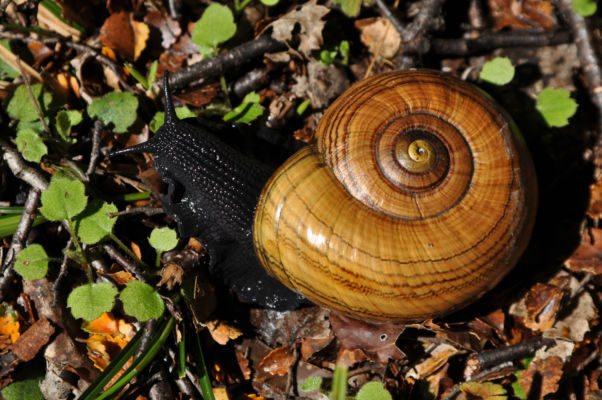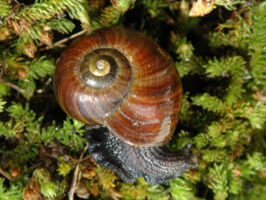Rats are quick and nimble. Snails… not so much. So our native snails are very much at the mercy of introduced rats, should rats choose to eat them. What’s more, there are a surprisingly large number of native snail species to protect.

New Zealand has, in fact, one of the most species-rich land-snail fauna in the world – with around 1400 species. That’s pretty impressive. What’s more, our native snails love to live in forests. An area of only a few square metres of native forest can contain snail communities of 30-70 different species among the leaf litter and vegetation.
So do hungry rats make a significant difference to our native snail populations? In research just published in the NZ Journal of Ecology, Gary M. Barker (Landcare Research, Hamilton), studied snails and Norway rats at nine different locations around New Zealand, in matched forestry blocks where rat control had and hadn’t been carried out. The paired blocks were located within 2–6.5 km of each other and of similar topography and vegetation type.

“Despite recognition of predation by rats as a threatening process in populations of some larger iconic species, the role of rats in structuring land snail communities has not been previously studied in New Zealand forests… The nine locations were selected from a suite of candidate sites at which intensive rat management was being undertaken primarily on the grounds that: (i) management of rats had been in place for at least five years; and (ii) nontreated forest was available in the vicinity that could serve as an appropriate control. The size of the treated forest blocks varied: Trounson 800 ha; Waitakere 1100 ha; Moehau 3000 ha; Te Urewera 1000 ha; Ruakuri 160 ha; Whareorino 300 ha; Boundary Stream 800 ha; Pukawa 50 ha; Takaka 18 ha.”
Relative abundance of Norway rats at the paired sites was measured using tracking tunnels and land snail populations were sampled and snail species identified.
“Sampling yielded 126,347 land snail specimens, representing seven families and 254 species. All but two species were native to the sampled locations. The number of individuals in samples for each treatment block averaged 7020 (range 3389–11,009) for ‘dead-collected’ plus ‘live collected’ snails, and 5270 (2583–8404) for ‘live collected’ snails.”
“A total of 78 species with specific maxima in shell dimension ≥4 mm were identified across the nine locations. When only these larger species were considered, forest block treatment effects were much more apparent than when including all species in the analyses. The pattern of community structure was consistent with predictions that management to reduce abundance of rats led to more abundant, and more species rich, larger-shelled land snail communities. Averaged across locations, larger-shelled species were 96% more abundant, the mean size of individuals increased by 11.5%.”
Rats could potentially be having both direct and indirect effects on native snails – by eating the snails themselves (particularly the larger ones) and, for example, by changing the habitat and eating the food that snails might otherwise eat. It is, however, difficult to determine the extent to which rats eat snails.
“The presence of land snails in Rattus stomach and faecal samples has been infrequently reported and as a consequence land snails are often considered as an insignificant dietary component. The limitation of stomach and faecal analyses is well recognized and in the case of land snail prey their inclusion in the diet of Rattus may be overlooked because shells may be fragmented and discarded during the predation event and thus not ingested, of rapid digestion of digested soft tissues, and the presence of few post-gastric diagnostic residues. Land snail radular teeth and jaws provide useful post-gastric diagnostic items in diet analyses but are generally overlooked because of their small size or they are simply not recognized.”
Further research is needed to see whether rats are targeting larger snail specimans and also on the effects of predation by mice and hedgehogs, whose numbers might also have been affected by the predator control regime.
“That rats may be differentially affecting land snails of different body sizes has important consequences for conservation management, and so it is important to understand the underlying mechanisms. It is also unclear as to the level of effect the rat management regimes had on abundance of mammals such as house mouse and hedgehog, both of which predate on invertebrates, including land snails and are pervasive in New Zealand forests.”
The full article is published in the NZ Journal of Ecology and is freely available.
Land snail communities respond to control of invasive rats in New Zealand forests (June 2016)

